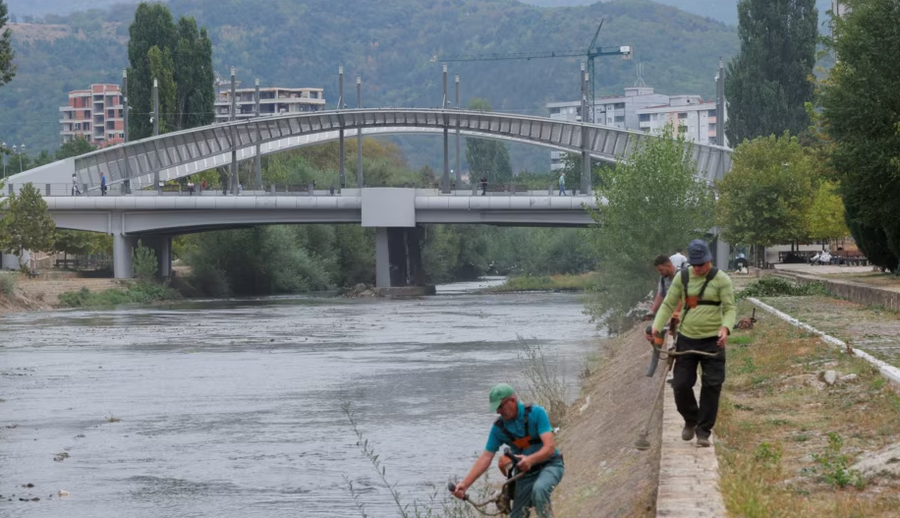
The caretaker Kosovo government's plans to build two new bridges over the Ibar River in divided Mitrovica have sparked strong reactions among local Serbs, who see the move as a political provocation rather than a means of connecting communities.
While authorities in Pristina claim that the goal of the projects is "integration and development", some citizens and local representatives warn that such a decision, taken without consultation with communities, could further increase tensions between the north and south of the city.
Marina from North Mitrovica says this is “a hasty decision by the Kosovo authorities to demonstrate their power over the citizens of the north.”
"We all know that those two bridges are not needed by the city at all and cannot contribute to any 'approximation' or 'strengthening of communication' between citizens on both sides of the Ibar, but serve exclusively as a means to sow paranoia among the Serbian population of the north," Marina tells Radio Free Europe.
She recalls that there are functional bridges for traffic and that citizens of North and South Mitrovica can also cross on foot through the main bridge over the Ibar.
For Ana, the idea of building two bridges over the Ibar, in addition to the main one, is "completely pointless."
"It seems more like a pre-election promise and message to the electorate, rather than real care for citizens and the way they function. The Municipality of North Mitrovica should deal with other issues, not with ideas that have no substance," she says.
Kosovo authorities announced last week the construction of two new bridges over the Ibar River.
Based on an illustrative photograph, published by the Vetëvendosje Movement of the acting Prime Minister, Albin Kurti, it can be seen that they will be placed on the left and right sides of the main bridge, which is part of the Kosovo-Serbia Agreement on Freedom of Movement, reached within the framework of the dialogue for the normalization of relations in Brussels.
However, the EU told Radio Free Europe that they are not involved in this project and are not even aware of it.
According to the EU, any decision to build infrastructure on the Ibar River must be made carefully and in a comprehensive manner - fully involving all communities affected by the issue.
The acting government of Kosovo did not respond to Radio Free Europe's request to provide more details about the construction of these bridges, namely when their construction is planned, whether they will be open to traffic, and more.
The government did not respond to a request to comment on the EU's position on the inclusion of all communities in the decision to build bridges.
Do citizens need new bridges?
The construction of two new bridges over the Ibar River was planned based on a memorandum of cooperation between the Ministry of Infrastructure of the Government of Kosovo and the municipalities of North and South Mitrovica.
Acting Minister of Infrastructure, Liburn Aliu, said that this project "will facilitate the movement of citizens and will serve as infrastructure for communication, integration and development between the two parts of the city."
The decision to open the bridge was made in the North Mitrovica Municipal Assembly in April 2023, but has not yet been implemented.
However, a councilor in the North Mitrovica Municipal Assembly from the Serb community, Dušan Milunović, believes that these bridges are unnecessary.
He says that no one consulted with the citizens about their needs and that the issue was not even discussed in the Municipal Assembly sessions.
According to him, there are much more important issues that local authorities in northern Mitrovica need to address.
The construction of these bridges “will negatively affect the overall situation,” says Milunovic.
"If we had solved all the city's problems, such as roads, sewers, infrastructure... If it were time to build bridges, I would understand. But, unfortunately, the situation on the ground is not like that," he tells Radio Free Europe.
Milunović is the only councilor in the Municipal Assembly of North Mitrovica from the Serbian community who did not leave his position as part of the collective withdrawal of Serbs from Kosovo institutions in November 2022.
He believes that, in recent years, Kosovo authorities have constantly "created new tensions" and adds that the construction of bridges is being presented as "the unification of North and South Mitrovica, so people are afraid."
The city of Mitrovica was divided in the post-war period, and in 2013 it was officially divided into two municipalities: South Mitrovica, inhabited by an Albanian majority, and North Mitrovica, inhabited by a Serb majority.
In mid-June of this year, a joint board of these two municipalities was formed, based on the Law on Administrative Boundaries of Municipalities, with the aim of "bringing citizens closer together."
The Mayor of North Mitrovica, Erden Atiq, was then asked if the formation of the board meant a step towards unifying the city into a single municipality, but he categorically denied this.
Sadiku: I support building bridges, but now is not the time
The Deputy Mayor of the North Mitrovica Municipal Assembly, Skender Sadiku, says that he supports any construction of bridges, as they are a symbol of the connection between people, cultures and differences, but adds that at the moment, there are more priority issues to address.
"This is not the right time to start [building bridges]. Let's not forget that local elections are approaching - these bridges serve politicians more than ordinary citizens. Every citizen of Mitrovica needs bridges, but we don't have a cultural center, our school is in a container, we have many displaced people, not only from the Albanian community. There are bigger priorities, bridges need to be built, but we need to go with priorities," Sadiku tells Radio Free Europe.
He believes that central and local authorities should have consulted with citizens before making the decision to build two bridges over the Ibar, as this is a decision "of great importance."
According to him, the construction of new bridges should have been planned after the main bridge was opened to traffic.
Members of the Serbian community should understand that something like this would also be in their interest, says Sadiku.
Previous attempts to open the main bridge
Last summer, the Kosovo Government took an initiative to open the main bridge over the Ibar to traffic - which was opposed by the local Serb population and the international community.
The NATO mission in Kosovo, KFOR - whose soldiers are stationed at the main bridge over the Ibar River - said at the time that any decision on opening the bridge should be made within the framework of the dialogue between Kosovo and Serbia, which is mediated by the European Union.
The then US Ambassador to Kosovo, Jeffrey Hovenier, told Radio Free Europe that there is a real risk from the opening of the bridge in Mitrovica, which could affect the safety of NATO soldiers, including American soldiers.
"We take very seriously any action that could affect the safety and security of American soldiers working in support of Kosovo," the American ambassador said at the time, expressing hope that the Kosovo Government would take "these concerns" into account.
Kosovo Prime Minister Albin Kurti later stated that his government would continue consultations and coordination regarding the opening of the bridge, noting that this issue is not directed against anyone.
This bridge is known for ethnic conflicts in the post-war period and this is the main reason for its closure to vehicle traffic.
Members of the Serb community from North Mitrovica previously told Radio Free Europe/Radio Liberty that opening the main bridge would only increase tensions on the ground, while Albanians from South Mitrovica stated that such an action would contribute to coexistence and freedom of movement.
In 2014, Kosovo and Serbia agreed to open the bridge to traffic, as part of the dialogue to normalize relations.
The so-called revitalization of the bridge was planned with the aim of removing all barricades placed by local Serbs and making the bridge functional.
Then, in 2016, a new implementation plan was adopted, aimed at overcoming disagreements over different interpretations of previous findings.
According to the new implementation plan, the full opening of the bridge was supposed to take place in January 2017.
The works on the revitalization of the bridge were only completed in June 2018 and the bridge, in which 1.5 million euros were invested, was never opened to vehicles, but only to pedestrians./ REL (A2 Televizion)










